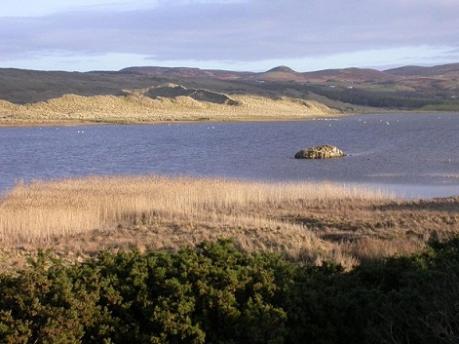
Most of Donegal’s inland lakes are too acidic to support much wildlife, but out along the coast we have four special ones which are brilliant habitats for birds, particularly in winter.
Inch Lake is the stretch of water between Inch Island and the mainland, bordered on one side by the causeway that takes the road across to the island, and on the other by the Farland Bank. Two birdwatching hides on the mainland embankment and one on the island side of Farland are well placed for viewing in comfort. Just about three miles to the south-west along the Swilly estuary is another great spot known as Blanket Nook, tucked in behind the old railway embankment.
Moving up to the north coast, the New Lake at Dunfanaghy was created around a century ago when too much cutting of marram grass caused a big blow-out of sand, which cut off the upper end of the tidal channel and formed the lake. And down in south Donegal, the main focal point is at Durnesh Lough near Rossnowlagh, which is a sort of natural lagoon.
People are often surprised to discover how many different wild duck species there are – at least a dozen to be seen regularly around Donegal. Most of them are winter visitors, and these coastal lakes are some of the best spots in the county for the diving ducks and the dabblers. The most common dabblers are Mallard, Wigeon and Teal but you could also come across a few Shoveller, with big spade-beaks, or an occasional Pintail. These feed in shallow water close to the shore, sifting items off the surface or upending to dabble in the mud below. Diving ducks stick to deeper water, constantly disappearing under the surface to feed on the lake floor and popping up again. Pochards prefer plant material, while Tufted Duck and Goldeneye like a more meaty diet of molluscs and insect larvae, so the food supply is well shared out.
The sight and sound of wild Whooper Swans is one of the highlights of winter. What could be a better symbol of the season than a V-formation of these beautiful white birds streaming overhead, with their lovely musical bugling call drifting across the countryside? Whoopers breed in Iceland, moving south in the autumn, and about two-thirds of them spend the winter in Ireland. Since 1988, their migration routes have been carefully studied and the area around Lough Swilly has proved to be their prime staging-post, with 60% of the Irish total touching down here when they arrive and 80% gathering before departure in the spring. They spread out across the country in the winter months but at any one time we could have a couple of thousand in Donegal, and our coastal lakes are some of their favourite haunts. Whoopers usually pair for life and can live for up to 25 years. The young ones remain with their parents for their first winter and you can pick out the family parties – two or three juveniles with greyish beaks, compared with the bright yellow and black beaks of the adults. The beak is also the main way to distinguish Whoopers from resident Mute Swans – the Mutes have an orange beak with a large black knob on top.
Moving away from the coast to some of our cold inland lakes, there’s a fishy story going on here which is well worth telling. Arctic Charr have a more northerly range than any other freshwater fish. Originally they behaved much like their Salmon relations, travelling up and down rivers, breeding in fresh water and moving out to the sea to feed and grow. Around 13,000 years ago when the great ice sheet covering northern Europe began to melt, these cold water specialists were the first to arrive in Irish rivers, but as the ice retreated further northwards, sea levels dropped back and many Charr found themselves cut off in deep inland lakes. Here they settled down in the cool depths, remaining quite small and eking out a meager living.
So for thousands of years these separate populations have survived, each one in its own lake, with no mixing or interbreeding. Different lakes have produced different sizes and colourings, feeding and spawning habits, and all of this makes them very interesting for scientific study. In Ireland we used to have around 70 separate populations, but one-third of these are now extinct. Lakes have suffered from acidification and all sorts of pollution, and there were also careless introductions of other fish species which competed with the residents. Donegal still has around a dozen lakes where Charr have been recorded in recent times, but there is now some evidence that numbers could be dwindling. It’s important now to find out how they are faring, and to make sure that these unique populations get the protection they need.
Four to find this monthPied Wagtail: originally a bird of shoreline and riverbank, this cocky little character has made itself very much at home in man-made surroundings. Their constant tail-wagging while searching for food is a real mystery, for it has nothing to do with attracting a mate or defending territory, and must surely risk catching the eye of predators. |